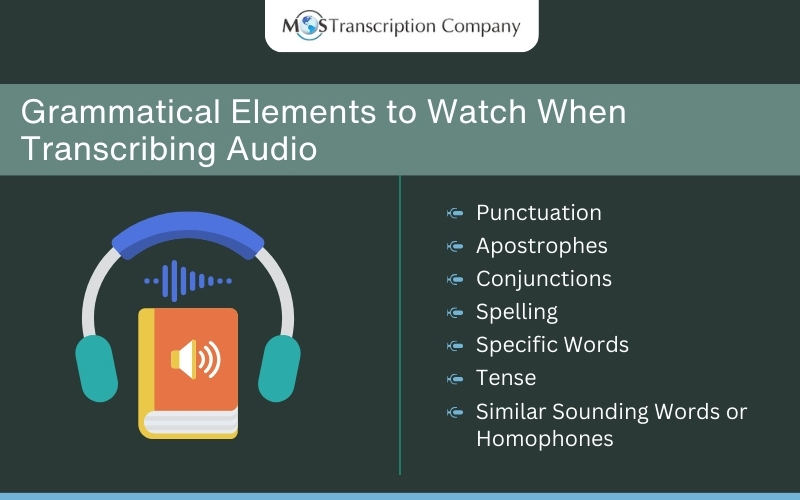
Converting audio recordings of meetings, podcasts, video conferences, and interviews into text, whether undertaken independently or using automatic speech recognition (ASR) or audio transcription services, offers a plethora of advantages. It enhances content accessibility, facilitates quick information retrieval through keywords, promotes knowledge sharing, and contributes to improved SEO, among other benefits. However, it is imperative to ensure that the resulting text is free of grammatical errors, as linguistic accuracy is fundamental to successful communication. Documents with grammatical inaccuracies can lead to misinterpretation, potentially influencing decisions or actions adversely.
Grammatical Pitfalls to Avoid during Audio Transcription
When performing audio transcription, it’s essential to be vigilant about potential grammatical errors to maintain accuracy and clarity.
Here are common errors to avoid:
Misinterpretation of homophones: Incorrectly transcribing words that sound similar but have different meanings (e.g., “their,” “there,” and “they’re”) can lead to confusion.
Example: “They’re going to their house” might be mistakenly transcribed as “There going to they’re house.”
Subject-verb agreement: Ensure that the subject and verb agree in number (singular or plural) to maintain grammatical correctness.
Example: “The team are working” should be transcribed as “The team is working.”
Punctuation errors: Incorrect punctuation can alter the meaning of a sentence. Pay attention to commas, periods, question marks, and other punctuation marks.
Example: “Let’s eat, Grandma!” versus “Let’s eat Grandma!”
Incomplete or run-on sentences:Transcribe complete and grammatically correct sentences to convey the intended meaning accurately.
Example: “He went to the store, he bought some groceries” should be transcribed as two sentences: “He went to the store. He bought some groceries.”
Verb tense consistency: Maintain consistency in verb tenses within a sentence or paragraph to avoid confusion.
Example: “She is walking, and then she runs to catch the bus” should be transcribed as “She is walking, and then she runs to catch the bus.”
Ambiguous pronoun reference: Be clear about the antecedent of pronouns to avoid ambiguity in the transcription.
Example: “John told Mark he would call him back” might be unclear; it’s better to specify, “John told Mark that John would call Mark back.”
Neglecting sentence structure: Maintain the correct structure of sentences to convey the speaker’s intended meaning accurately.
Example: “After finishing his breakfast, the doorbell rang” could be corrected to “After he finished his breakfast, the doorbell rang.”
Misplacing modifiers: Ensure that descriptive words or phrases are placed appropriately to avoid confusion.
Example: “She almost drove her kids to school every day” might be misinterpreted; it’s better as “She drove her kids to school almost every day.”
Word omission or repetition: Avoid omitting or repeating words, as it can change the meaning of a sentence.
Example: “She goes to the gym on Monday, Tuesday, Wednesday, Thursday, and Friday” should be transcribed without repetition as “She goes to the gym on Monday through Friday.”
Ignoring speaker corrections: If the speaker corrects themselves, ensure that the transcription reflects the corrected version for accuracy.
Example: “I went to the store, uh, I mean the bank” should be transcribed as “I went to the bank.”
By being mindful of these common grammatical pitfalls, you can produce accurate and comprehensible transcripts. Investing in top-notch audio equipment is also important to ensure clear recordings and reduce the risk of mistakes.
One of the best ways to ensure accuracy in transcription is to rely on a professional online transcription company. Such companies employ transcriptionists with excellent language skills. In addition, they have multi-tier quality checks in place, where transcripts are diligently proofread to ensure top accuracy.
Transform your audio-to-text documentation with quality audio transcription services!




